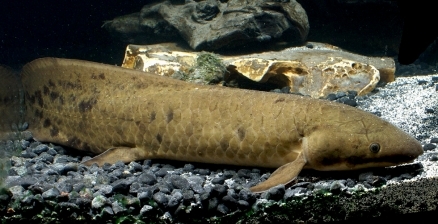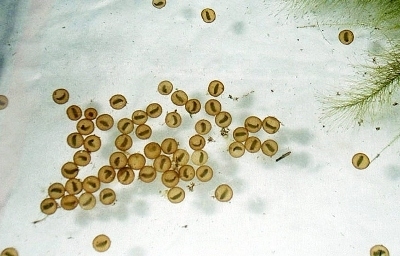Australian Lungfish (Biodiversity)
Contents
Australian Lungfish

Captive Australian lungfish (Neoceratodus forsteri). © Dr. Solomon R. David, http://primitivefishes.com
The Australian lungfish Neoceratodus forsteri is one of six species andthree generain the sub-class Dipnoi (lungfishes). N. forsteri is the lonememberof the family Ceratodontidae, the remaining families of Dipnoi being Lepidosirenidae and Protopteridae. Protopteridae contains four species in thegenera Protopterus, which are all endemic to South and Central Africa. The family Lepidosirenidae contains one species, Lepidosiren paradoxa, endemic to South America. Theextinct Scaumenacia,one of theearliest lungfishes,swamthrough ancientDevonian waters 400 million years ago. The Australian lungfish isthought to betheleastderived of the extantlungfishes asN. forsteri shares many morphological traits withancient Dipnoans (including Scaumenacia).These shared traits includea single lung, deep bodies, large cycloid scales,muscularpaired fins andbroad diphycercal tails. Fossilized toothplates,identical to those of livingN. forsteri, have been found in Early Cretaceous deposits,attesting to the notionthatthe Australian lungfishis 140 million years old. The Australian lungfishmay justbe the oldestliving vertebrate.
|
Embryonic Australian lungfish developing within the eggs. Photo courtesy of Dr. Roger Guo, www.ceratodus.com. 10-12 inchJuvenile Neoceratodus forsteri. Photo courtesy of Dr. Roger Guo, www.ceratodus.com. 1.4 meter wild adult Australian lungfish Neoceratodus forsteri. Courtesy of Heinz Machacek, www.fishing-worldrecords.com. |
|
Conservation Status |
|
Scientific Classification Kingdom: Animalia |
Physical Description
The body is large and deep with dark brown coloration covering the dorsal region and white to pink coloration on theventral region. Thehead is flattened with small eyes and asmall mouth that is gapelimited. Large, cycloid scales run the length of the body. The Australian lungfish has paddle-like pelvic and pectoral fins (compared to the thread-like paired fins of the African and South American lungfishes). Thecaudal fin is broad and diphycercal.A single lung is thought to function more in buoyancy or to sustain elevated levels of activitythan for respiration. N. forsterigrows to 1.5 meters in length and up to 40 kilograms in weight. Sometimes called the "Burnett River salmon" due to its pink flesh.
Behavior
The Australian lungfish is a facultative air breather, relying mostly on well-developed gills torespire. Intake of atmospheric oxygen only occurs frequently whenthe fish is stressed, suchas living in polluted waters or during thebreeding season.This is a stark contrast to the African and South American species of lungfishes, which are obligate air breathers, relying more on atmospheric oxygen for respiration. African and South American lungfishes can survive desiccation (drought) by constructing underground burrows and enveloping themselves in a cocoon for roughly 7 to 8 months, emergingwith the returningrainy season. The Australian lungfishdoes not exhibitsuch estivation behavior. Although, Australian lungfish do burrow insubmerged substrates, presumablyto rest or avoid predation.
Reproduction
Sexual maturity is attained at an age of approximately 15-20 years of age.An increasing photoperiod (longer days)produces the onset of egg production in females. The bellies ofN. forsteri become increasinglycolorful when preparing tobreed.Spawning occurs between August and Decemberin the clean, flowing rivers of Southeastern Queensland and individuals habitually return to the same spawning sites. Spawning of N. forsteri includes elaborate courtship behaviors between mating pairs. Eggs are laid onaquatic plantsor roots along the bankthroughout the day or night. Females lay between50-100 eggs per spawning event. Offspring develop directly, meaning there is no larval stage typical of many fishes. Unlike the South American and African lungfishes, the Australian lungfish does notconstruct a nest andthere is no parental care followingthe breeding event. Hatchling lungfish are sheltered from predators by a mass of vegetation and anegg capsule, which the young fish can dart into when predators are near. Young lungfish not only respirethrough gills, but also through the skin (cutaneous respiration) much like many larval fishes and certain amphibians.
Lifespan/Longevity
Australian lungfish are long-lived fish that do not reach sexual maturity until approximately 15-20 years of age. Individuals in captivity have lived as long as 70 years. Wild individuals have been estimatedas living up to100 years. This milestone in ageis seenin other fishes that reach sexual maturity late in life and grow slowly, like the sturgeon fishes(Acipenseridae) of North America and Eurasia.
Distribution & Movements
Endemic toSoutheastern Queensland with historicalpopulations in the Mary andBurnett Rivers, twobodies of water withsimilarwater parameters and wildlife.The species was first described in the Auburn River, atributary of the Burnett River system. There has been some debate on whether populations have occurred naturally or have been introduced into the Brisbane, Fitzroy, and North Pine Rivers.Since the 1800's, the Australian lungfish has been introduced into many othersmall reservoirs south of the Mary Riverto aid in the recovery ofthe species. Though, it is unknown whether the introduced populations will subsist or become extirpated.
Habitat
Australian lungfish are benthic fishes, living in or near the bottom of the water column.They can be found in both lotic and lentic environments, but are found mainly in the flowing waters or deep pools of rivers systems. In the Brisbane River, temperatures range from 13-25ºC and thepHranges from 6.0-7.8 inwaters where the species is found. Many of the riversin whichtheAustralian lungfish inhabitsare turbid due to tannins, thus restricting light levels.Prime microhabitat for N. forsteriis sheltered areassuch assubmerged logs, caves, leaf litter, vegetation, and detritus. Submerged aquatic plants or dense root systems near the bankare essential spawning andnursery habitat for young lungfish.Since 1999,a prolonged drought in Southeast Queensland has restricted the spawning habitat of lungfish.
Food & Feeding Habits
The Australian lungfishbegins foraging in the evening and continues throughout the night. Ampullary receptors in the skin ofN. forsteriact as electroreceptors, enabling the fishto locate prey buried in sediments and leaf litter.A well-developedlateral line system aids inthelocation ofprey during foraging hours whenlight levels are low. Olfactory (smell)organs in the mouth add to thelist of tools for prey location.The dietconsists of crustaceans, mollusks, small fishes (including younglungfish), amphibians,and plant matter. Heavily armored prey items(mollusksandcrustaceans)arelight workfor the Australian lungfish'scrushing toothplates. Once prey is caught by a powerful suction mode, prey are repeatedly sucked in the mouth, crushed with the toothplates, and spit back out until the prey is ready to be ingested. Hatchlinglungfishfeed mainly on zooplankton andalgae. As the fish continues to grow into ajuvenile,the diet will expand to includeworms, prawns, snails, and eventually aquatic plants.
Predation
Australian lungfish are not utilized as food as they are protected by the Australian federal government. Historically, lungfish could succumb to the powerful jaws of crocodiles (crocodylidae);though, crocodiles have longsincebeenextirpated from Queensland.Adult lungfishlive relativelyfree from predationassubmerged sheltersact as protection.If needed,a quick thrust of the musculartrunk and broad caudal fin can act as an escape mechanism. Young lungfish can fall prey to a number of predators including other fishes and insects.
Threats & Conservation Status
The Australian lungfish was deemed Vulnerable in 2003 by Australia's federal Environmental Protection and Biodiversity Conservation Act. The Convention on International Trade in Endangered Species of Wild Fauna and Flora (CITES) lists the Australian lungfish in Appendix II, meaning that the species is not currently threatened, but may become threatenedin the future if not properly protected.Wild populations of N. forsteri are protected by theFisheries Act of 1994, which requires a special permit to collect an Australian lungfish in Queensland.The destruction of spawning and nursery habitat, pollution, invasive species, and low recruitmentare themajor factors contributing to the decline ofthe Australian lungfishin its native range. Fluctuating water levels, due to the establishment of dams in the past 50-60 years,has prevented the growth of aquatic plants along the littoral zone, which iscrucialbreeding and nurseryhabitat forlungfish.Invasive species like thetilapia Oreochromis mossambicus,acichlid native to Africa, compete with Australian lungfish throughegg predation and habitat space.
Further Reading
- Graham, Jeffrey B. 1997.Air-Breathing Fishes: Evolution, Diversity, and Adaptation. Academic Press.
- Helfman, Gene S., Bruce B. Collette, Douglas E. Facey, & Brian W. Bowen. 2009. The Diversity of Fishes: Biology, Evolution, and Ecology. 2nd edition. Wiley-Blackwell West Sussex, United Kingdom.
- Kemp, Anne. 2008. The Natural History of the Australian Lungfish. Center for Marine Studies, University of Queensland.
- Threatened Species Scientific Committee (TSSC). 2011. Neoceratodus forsteri (Queensland Lungfish, Australian Lungfish). http://www.environment.gov.au/biodiversity/threatened/species/n-forsteri.html.
- Watt, M., C. S. Evans, & J. M. Joss. 1999. Use of electroreception during foraging by the Australian lungfish. Animal Behavior Vol. 58: pg. 1039.



